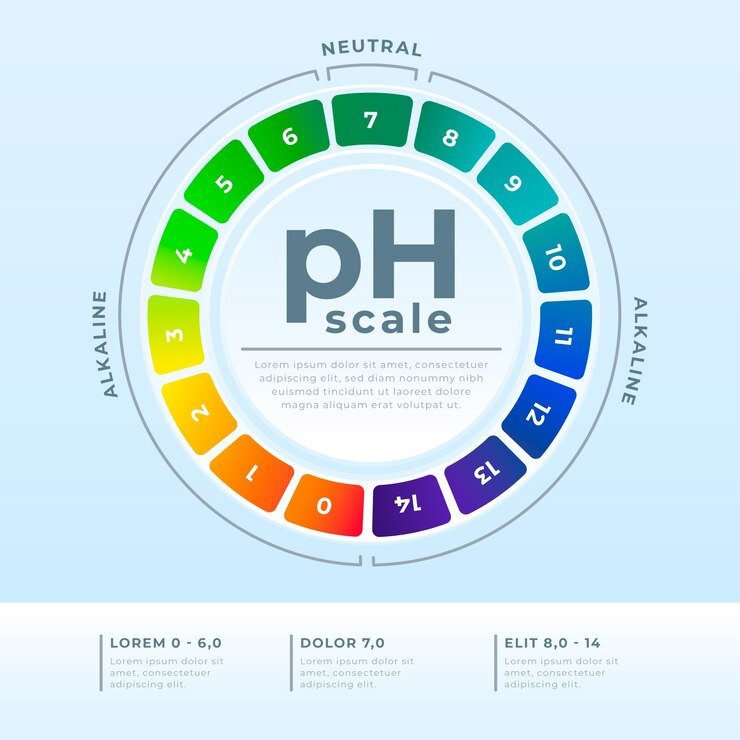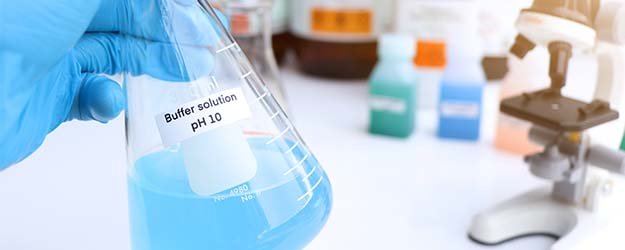Experiment 20: Preparation and Testing of Buffers
PURPOSE
The primary objective of this experiment is to prepare and show you how to calculate the pH of buffers of varying pH values. These buffer solutions will then be subjected to the addition of acids and bases to test their actual buffering capacity.
BACKGROUND
A buffer is a solution, prepared from a weak acid/base and its conjugate base/ acid (common ion), which is designed to resist changes in pH. A buffer is chosen for a particular application based on several characteristics, including: suitable pH of the conjugate acid/base system (usually desired pH = pKa + 1); buffering capacity (how well it will resist changes to pH when challenged with acid or base, which often result as a product of a side-reaction); and composition (whether the buffer components interfere with the reaction or application of interest).
The pH of an acidic buffer may be determined using the Henderson-Hasselbach equation:
pH + pOH=14
While we do spend significant time in lecture calculating pH values of acids, bases, buffers, and titrations, it is important to observe and understand what actually happens (experimentally) when buffers are prepared and tested.
MATERIALS
Laptop or LabQuest 2 (Checkout from stockroom)
pH electrode; pH calibration standards
Utility clamp (for pH electrode)
Kimwipes
Three 25-mL volumetric flasks
One 10-mL volumetric flask
Two 50-mL beakers
Two 10-mL beakers (Checkout from stockroom)
10-mL graduated cylinder
Optional: magnetic stir bar/ stir plate
6* M acetic acid
6* M ammonium hydroxide 0.1* M hydrochloric acid 0.1* M sodium hydroxide (*1 significant figure) Solid sodium acetate Solid ammonium chloride Solid sodium bicarbonate 1-4 mL volumetric pipets DI water


Order Custom Paper
Unlock your academic potential—order your custom paper from an expert today and enjoy a 15% discount on your first order!
Order Now
PROCEDURE
A. Acetate Buffer
Preparation and Testing
M acetic acid. This solution will be the stock solution for the next step. 1. Using a volumetric flask, make 10.00 mL of 0.6 M acetic acid from the 6 2. Using a volumetric flask, prepare 25.00 mL of 0.1 M acetic acid/0.1 M sodium acetate buffer. Add the calculated quantities of sodium acetate (you may dissolve the solid in about 5 mL of DI water first) and acetic acid to the same volumetric flask (use a volumetric pipet to measure the acetic acid, round the calculated volume to the nearest milliliter), then dilute to the mark with water. Mix thoroughly. Calculate the actual molarity of the buffer using the proper precision (sig figs).
3. Set up two burets, one containing about 10 mL of HCl and the other one containing about 10 mL of NaOH. Record the initial volumes of each substance.
4. Calibrate the pH electrode using the General Instructions in Appendix Q.
5. Measure two 10-mL aliquots of buffer into separate 50-mL beakers. Measure and record the pH of this buffer.
6. With the pH electrode in the first buffer solution, slowly (dropwise) add the acid to the buffer until the pH changes. Record the pH (and final volume) when the pH changes by 1 pH unit. (NOTE: you may stir the beaker manually or use the magnetic stir plate and bar)
7. Repeat the procedure in step #6 with the second beaker and the NaOH solution. Make sure you clean the stir bar between uses so that it does not contaminate your buffer solution.
B. Ammonia Buffer
1. Using a volumetric flask, prepare 25.00 mL of 0.25 M ammonia/0.25 M ammonium ion buffer. Add the calculated quantities of ammonium chloride (you may dissolve the solid in about 5 mL of DI water first) and then (use a volumetric pipet and round calculated volume to the nearest milliliter) add ammonium hydroxide to the same volumetric flask. Next, dilute to the mark with water. Mix thoroughly. Calculate the actual molarity of the buffer using the proper precision (sig figs).
2. Use the HCl and NaOH solutions remaining in the burets from part A. Refill the burets so each one contains about 25 mL of each substance, and record the initial volumes.
Preparation and Testing of Buffers
Measure and record the pH of this buffer. Measure two 10-mL aliquots of buffer into separate 50-mL beakers.
With the pH electrode in the first buffer solution, slowly (dropwise) add the acid to the buffer until the pH changes. Record the pH (and final volume) when the pH changes by 1 pH unit. (NOTE: you may stir the beaker manually or use the magnetic stir plate and bar)
5. Repeat the procedure in step #4 with the second beaker and the NaOH solution. Make sure you clean the stir bar between uses so that it does not contaminate your buffer solution.
C. Bicarbonate Buffer
1. Using a volumetric flask, prepare 25.00 mL of 0.25 M sodium bicarbonate, and record the pH.
2. Transfer the entire buffer into a beaker, and use either HCl or NaOH in the buret, adjust the pH to 7.40 (± 0.02). Record this adjusted pH value. Record the initial and final volumes, so that you know what volume was added. Recalculate the molarity of the buffer ([bicarbonate] AND [carbonic acid]), based on this dilution (assume that the volumes are additive and that there is no solution expansion). This is the buffer you will be using for the next steps.
3. Use the HCl and NaOH solutions remaining in the burets from part B. Refill the burets so each one contains about 10 mL of each substance, and record the initial volumes.
4. Measure two 10-mL aliquots of buffer into separate 50-mL beakers.
5. With the pH electrode in the first buffer solution, slowly (dropwise) add the acid to the buffer until the pH changes. Record the pH (and final volume) when the pH changes by 1 pH unit. (NOTE: you may stir the beaker manually or use the magnetic stir plate and bar)
6. Repeat the procedure in step #5 with the second beaker and the NaOH solution. Make sure you clean the stir bar between uses so that it does not contaminate your buffer solution.

Chris Cavanaugh
Chemistry Professor
Contact Me For More Guides and One of one Lessons


